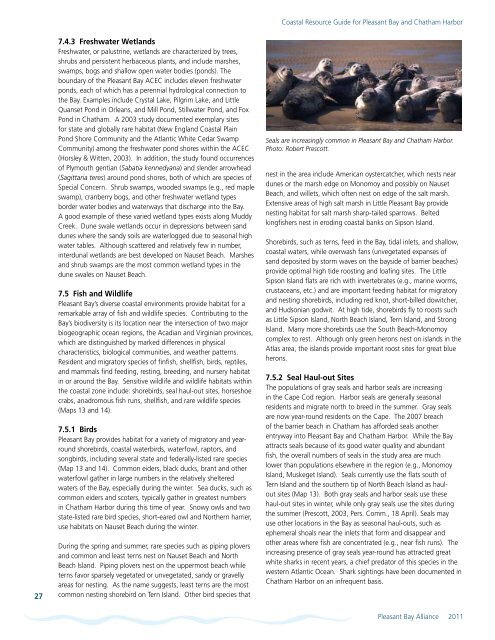Coastal Resource Guide Pleasant Bay and ... - Town to Chatham
Coastal Resource Guide Pleasant Bay and ... - Town to Chatham
Coastal Resource Guide Pleasant Bay and ... - Town to Chatham
You also want an ePaper? Increase the reach of your titles
YUMPU automatically turns print PDFs into web optimized ePapers that Google loves.
277.4.3 Freshwater Wetl<strong>and</strong>sFreshwater, or palustrine, wetl<strong>and</strong>s are characterized by trees,shrubs <strong>and</strong> persistent herbaceous plants, <strong>and</strong> include marshes,swamps, bogs <strong>and</strong> shallow open water bodies (ponds). Theboundary of the <strong>Pleasant</strong> <strong>Bay</strong> ACEC includes eleven freshwaterponds, each of which has a perennial hydrological connection <strong>to</strong>the <strong>Bay</strong>. Examples include Crystal Lake, Pilgrim Lake, <strong>and</strong> LittleQuanset Pond in Orleans, <strong>and</strong> Mill Pond, Stillwater Pond, <strong>and</strong> FoxPond in <strong>Chatham</strong>. A 2003 study documented exemplary sitesfor state <strong>and</strong> globally rare habitat (New Engl<strong>and</strong> <strong>Coastal</strong> PlainPond Shore Community <strong>and</strong> the Atlantic White Cedar SwampCommunity) among the freshwater pond shores within the ACEC(Horsley & Witten, 2003). In addition, the study found occurrencesof Plymouth gentian (Sabatia kennedyana) <strong>and</strong> slender arrowhead(Sagittaria teres) around pond shores, both of which are species ofSpecial Concern. Shrub swamps, wooded swamps (e.g., red mapleswamp), cranberry bogs, <strong>and</strong> other freshwater wetl<strong>and</strong> typesborder water bodies <strong>and</strong> waterways that discharge in<strong>to</strong> the <strong>Bay</strong>.A good example of these varied wetl<strong>and</strong> types exists along MuddyCreek. Dune swale wetl<strong>and</strong>s occur in depressions between s<strong>and</strong>dunes where the s<strong>and</strong>y soils are waterlogged due <strong>to</strong> seasonal highwater tables. Although scattered <strong>and</strong> relatively few in number,interdunal wetl<strong>and</strong>s are best developed on Nauset Beach. Marshes<strong>and</strong> shrub swamps are the most common wetl<strong>and</strong> types in thedune swales on Nauset Beach.7.5 Fish <strong>and</strong> Wildlife<strong>Pleasant</strong> <strong>Bay</strong>’s diverse coastal environments provide habitat for aremarkable array of fish <strong>and</strong> wildlife species. Contributing <strong>to</strong> the<strong>Bay</strong>’s biodiversity is its location near the intersection of two majorbiogeographic ocean regions, the Acadian <strong>and</strong> Virginian provinces,which are distinguished by marked differences in physicalcharacteristics, biological communities, <strong>and</strong> weather patterns.Resident <strong>and</strong> migra<strong>to</strong>ry species of finfish, shellfish, birds, reptiles,<strong>and</strong> mammals find feeding, resting, breeding, <strong>and</strong> nursery habitatin or around the <strong>Bay</strong>. Sensitive wildlife <strong>and</strong> wildlife habitats withinthe coastal zone include: shorebirds, seal haul-out sites, horseshoecrabs, anadromous fish runs, shellfish, <strong>and</strong> rare wildlife species(Maps 13 <strong>and</strong> 14).7.5.1 Birds<strong>Pleasant</strong> <strong>Bay</strong> provides habitat for a variety of migra<strong>to</strong>ry <strong>and</strong> yearroundshorebirds, coastal waterbirds, waterfowl, rap<strong>to</strong>rs, <strong>and</strong>songbirds, including several state <strong>and</strong> federally-listed rare species(Map 13 <strong>and</strong> 14). Common eiders, black ducks, brant <strong>and</strong> otherwaterfowl gather in large numbers in the relatively shelteredwaters of the <strong>Bay</strong>, especially during the winter. Sea ducks, such ascommon eiders <strong>and</strong> scoters, typically gather in greatest numbersin <strong>Chatham</strong> Harbor during this time of year. Snowy owls <strong>and</strong> twostate-listed rare bird species, short-eared owl <strong>and</strong> Northern harrier,use habitats on Nauset Beach during the winter.During the spring <strong>and</strong> summer, rare species such as piping plovers<strong>and</strong> common <strong>and</strong> least terns nest on Nauset Beach <strong>and</strong> NorthBeach Isl<strong>and</strong>. Piping plovers nest on the uppermost beach whileterns favor sparsely vegetated or unvegetated, s<strong>and</strong>y or gravellyareas for nesting. As the name suggests, least terns are the mostcommon nesting shorebird on Tern Isl<strong>and</strong>. Other bird species that<strong>Coastal</strong> <strong>Resource</strong> <strong>Guide</strong> for <strong>Pleasant</strong> <strong>Bay</strong> <strong>and</strong> <strong>Chatham</strong> HarborSeals are increasingly common in <strong>Pleasant</strong> <strong>Bay</strong> <strong>and</strong> <strong>Chatham</strong> Harbor.Pho<strong>to</strong>: Robert Prescott.nest in the area include American oystercatcher, which nests neardunes or the marsh edge on Monomoy <strong>and</strong> possibly on NausetBeach, <strong>and</strong> willets, which often nest on edge of the salt marsh.Extensive areas of high salt marsh in Little <strong>Pleasant</strong> <strong>Bay</strong> providenesting habitat for salt marsh sharp-tailed sparrows. Beltedkingfishers nest in eroding coastal banks on Sipson Isl<strong>and</strong>.Shorebirds, such as terns, feed in the <strong>Bay</strong>, tidal inlets, <strong>and</strong> shallow,coastal waters, while overwash fans (unvegetated expanses ofs<strong>and</strong> deposited by s<strong>to</strong>rm waves on the bayside of barrier beaches)provide optimal high tide roosting <strong>and</strong> loafing sites. The LittleSipson Isl<strong>and</strong> flats are rich with invertebrates (e.g., marine worms,crustaceans, etc.) <strong>and</strong> are important feeding habitat for migra<strong>to</strong>ry<strong>and</strong> nesting shorebirds, including red knot, short-billed dowitcher,<strong>and</strong> Hudsonian godwit. At high tide, shorebirds fly <strong>to</strong> roosts suchas Little Sipson Isl<strong>and</strong>, North Beach Isl<strong>and</strong>, Tern Isl<strong>and</strong>, <strong>and</strong> StrongIsl<strong>and</strong>. Many more shorebirds use the South Beach-Monomoycomplex <strong>to</strong> rest. Although only green herons nest on isl<strong>and</strong>s in theAtlas area, the isl<strong>and</strong>s provide important roost sites for great blueherons.7.5.2 Seal Haul-out SitesThe populations of gray seals <strong>and</strong> harbor seals are increasingin the Cape Cod region. Harbor seals are generally seasonalresidents <strong>and</strong> migrate north <strong>to</strong> breed in the summer. Gray sealsare now year-round residents on the Cape. The 2007 breachof the barrier beach in <strong>Chatham</strong> has afforded seals anotherentryway in<strong>to</strong> <strong>Pleasant</strong> <strong>Bay</strong> <strong>and</strong> <strong>Chatham</strong> Harbor. While the <strong>Bay</strong>attracts seals because of its good water quality <strong>and</strong> abundantfish, the overall numbers of seals in the study area are muchlower than populations elsewhere in the region (e.g., MonomoyIsl<strong>and</strong>, Muskeget Isl<strong>and</strong>). Seals currently use the flats south ofTern Isl<strong>and</strong> <strong>and</strong> the southern tip of North Beach Isl<strong>and</strong> as hauloutsites (Map 13). Both gray seals <strong>and</strong> harbor seals use thesehaul-out sites in winter, while only gray seals use the sites duringthe summer (Prescott, 2003, Pers. Comm., 18 April). Seals mayuse other locations in the <strong>Bay</strong> as seasonal haul-outs, such asephemeral shoals near the inlets that form <strong>and</strong> disappear <strong>and</strong>other areas where fish are concentrated (e.g., near fish runs). Theincreasing presence of gray seals year-round has attracted greatwhite sharks in recent years, a chief preda<strong>to</strong>r of this species in thewestern Atlantic Ocean. Shark sightings have been documented in<strong>Chatham</strong> Harbor on an infrequent basis.<strong>Pleasant</strong> <strong>Bay</strong> Alliance 2011
















